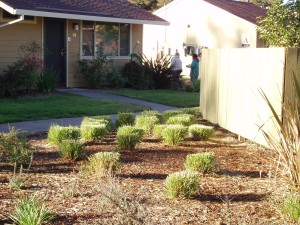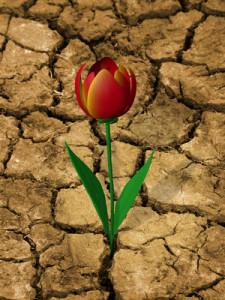Posts Tagged xeriscape
Go Native, Save Water: Xeriscape Gardening
 The information age has brought with it a flood a varying techniques in the fields of landscaping, gardening and ecological design. In keeping with the sustainable nature of the best of them, xeriscape gardening is defined by its optimal use of a minimal amount of water. This approach to gardening has been developed in the arid regions in the world, chiefly in the American mid-west, as a natural response to the climate. Xeriscape is most effective when the need for supplemental irrigation is eliminated and the design of the garden promotes symbiotic relationships that provide benefits. Environmental conservancy is xeriscape gardening’s top priority, but aesthetic design has received as much consideration. At its best, xeriscape becomes a melding of both utility and beauty.
The information age has brought with it a flood a varying techniques in the fields of landscaping, gardening and ecological design. In keeping with the sustainable nature of the best of them, xeriscape gardening is defined by its optimal use of a minimal amount of water. This approach to gardening has been developed in the arid regions in the world, chiefly in the American mid-west, as a natural response to the climate. Xeriscape is most effective when the need for supplemental irrigation is eliminated and the design of the garden promotes symbiotic relationships that provide benefits. Environmental conservancy is xeriscape gardening’s top priority, but aesthetic design has received as much consideration. At its best, xeriscape becomes a melding of both utility and beauty.
The Principles of Xeriscape
As conceived by Denver Water, xeriscape gardening’s most revered proponent, these seven guiding principles provide the foundation for all considerations within the field. Each principle holds an entire discipline within itself, which means that there is always more to learn and improve upon in this field.
- Planning and Design are the cornerstones of effective gardening, which requires careful attention to your specific environment.
- Soil Management is about knowing what nutrients your selected plants need and what nutrients are available in the soil. Composting is a great way to reinvigorate malnourished soil.
- Plant Selection is an integral part of xeriscape gardening. Thousands of species exist in arid conditions, each with benefits and beauty to offer.
- Turf Minimalism is crucial because the water needs of most grass lawns makes them impractical for dry climates.
- Diligent Irrigation may be the reason you’re interested in xeriscape gardening to begin with. Water is an invaluable resource and appropriate use of it is essential to environmental conservancy.
- Mulch can be composed of several materials such as leaves, wood chips, pine needles and bark. It is spread over the surface of the soil to help with water retention, fertility, prevention of erosion, and reduction of weed growth.
- Maintenance in the form of weed pulling, mulching, and general upkeep should be combined with constant observation to check if your garden layout is working to its full potential.
The Benefits of Xeriscape
- Reduced Water Consumption is both the key aspect of xeriscape gardening and a great benefit of it. It means using less water and making better use of it. Not only will this save you money, but you will be helping your community and environment as well. Re-appropriating rainwater can help you prevent evaporation and runoff, and your garden’s layout can be optimized for better use of it.
- Less Maintenance is required from a xeriscape garden. Much less fertilizer is used, which helps urban runoff pollution, lawn mowing becomes nigh unnecessary, and simple irrigation systems can handle all of your watering needs.
- Pest Control is an added benefit of a really well thought out garden layout. Certain xeriscape friendly plants ward off insects, while prickly cacti do the same for intrusive mammals. Plant selection also enables you to create a sanctuary for desirable birds and insects.
- Property Values Rise when you drought-proof the terrain around your home. Likewise, the design opportunities available to xeriscape can make for some exquisite gardens.
There are an abundance of tips and tricks available for do-it-yourself xeriscape gardening, but expert consideration reaps the true benefits of the art form. Xeriscape specialists develop an uncanny ability to read an environment and discern its possibilities. With a little help, and dedication to the sustainability principles of xeriscape you could be looking at a lower water and power bill, a productive and efficient garden, and a beautiful area in which to relax.
10 Ways to Save Water in Your Yard
 As a homeowner or business owner, it may seem impossible to keep your yard attractive and thriving while trying to save water. Whether your region is going through a drought, city water prices are through the roof, or your area is implementing bans on watering yards, learning how to save water is becoming essential.
As a homeowner or business owner, it may seem impossible to keep your yard attractive and thriving while trying to save water. Whether your region is going through a drought, city water prices are through the roof, or your area is implementing bans on watering yards, learning how to save water is becoming essential.
Here are 10 ways you can save water in your own yard:
1. Implement Xeriscape Landscaping
For decades, xeriscape has been practiced by the landscaping industry. This concept allows you to have a livable outdoor space that doesn’t require major amounts of water. While xeriscapes still need to be regularly maintained, their smart designs save water, as well as your time and major backaches in the long run.
But don’t try to implement the principles of xeriscape alone. Your local landscaping company will be your best resource for establishing one. According to LandscapeNetwork.com, “For anyone contemplating a xeriscape, selecting an experienced designer is vital to success… The skill set in demand is a firm knowledge of both local native species used for landscaping, plus the array of imported species from dry climates around the world that expand our options considerably. There is no better way to make your home environmentally green and create a model landscape for water conservation.”
2. Plant Native Plants or Drought-Resistant Plants
Use native plants in your yard to save water. These plants are acclimated to your climate and are used to your region’s rainfall. Drought-resistant plants like daylilies contribute bright, cheery colors to your yard’s design without hogging water.
3. Use Mulch
Mulch such as wood chips or lava rock (not black plastic) is handy at preventing weeds. However, it also keeps moisture in the soil. It shades soil so that the soil’s temperature doesn’t heat up, translating to water savings.
4. Adjust Sprinkler Irrigation Systems
If you use sprinklers but they’re not adjusted properly, they won’t save water. Mist settings may cause water to blow in the wind or evaporate before it reaches your thirsty yard. Settings with larger droplets ensure that the water is reaching your plants. Make sure sprinklers are pointed to your lawn and not spurting water wastefully at sidewalks.
5. Yard Watering
The time of day that you water plants is important. Plan on watering around cooler times of the day like dusk or dawn. This will ensure that you save water since the water isn’t merely evaporating before it hits the ground. Don’t water when it’s windy.
6. Harvest Rain Water
Rainwater harvesting means you accumulate and deposit rainwater on-site so it doesn’t merely create run-off. For example, rain barrels can capture rain coming off your roof. You can save water and money simultaneously!
7. Mow the Grass
If you mow your grass too much, you could be contributing to water waste. Keep your main lawn around 3 inches tall so the soil retains water but water isn’t merely soaked up by tall grass (which can also harbor pests).
8. Pay Attention to Fertilization Times
Don’t fertilize your lawns during hot, dry weather. This could exacerbate current drought problems. Use a slow-release fertilizer to save water.
9. Create Decks and Paths
Add patio stones, gravel paths, and decks to decrease the amount of area in your yard that needs to be watered. Your landscaping company will have ideas on how these items will look great in your yard but contribute to a functional design too.
10. Form Ditches and Basins
Form ditches and basins around your plants. This practice will keep a well of water near your plants’ roots.
Xeriscape Landscaping in Sonoma County
 Xeriscape Why?
Xeriscape Why?
Xeriscape became a word invented by Denver Water Department when forbidding watering in summer. Sonoma residents must:
- select plants appropriate to your climate,
- mulch plants to help them retain moisture
- care for your plants properly
- keep plants healthy
- Plant shrubs, trees and other attractive plants where grass used to be.
The foregoing basics reduce water consumption 60 percent. Instead of a monotonous expanse of lawn in shades of green to brown, your yard can become rich with variety and interesting to observers. Filling your yard with a variety of hardy drought tolerant plants indigenous to your area is making a pact with Mother Nature that you are on her side. You are now going to help her with a bounty of beautiful plants she worked over 1,000 years to perfect for your exact piece of land.
Prepare the Yard Soil
- Pick up a fistful of thoroughly wet soil from your yard and squeeze it into a ball. The ball will stay formed or will crumble apart.
- Add organic material to your soil if the ball of dirt crumbled quickly. Compost or manure helps crumbly soil retain moisture.
- Add sand or ground bark to the soil if the ball of dirt formed a tight, hard ball. Hard, clay soil allows all water to run off quickly before it even has a chance to reach a plant’s roots.
Grow Plants Nature Designed for Sonoma
- Grow plants native to the Sonoma parched earth. They adapted mechanisms over hundreds of years to tolerate and cope with your weather and water gauge, so require little watering. Landscape companies can recommend plants for you so that your unique taste can still be displayed in your xeriscape garden.
- Plant trees suited to dry landscaping, such as California buckeye, which though their seeds are poisonous, make great shaped trees. The U.S. Department of Agriculture plant hardiness dictates zones 6a and higher for Sonoma.
- Plant drought-tolerant xeriscape shrubs like California wild lilac, best in USDA zones 5b or higher with lovely flowers. California wild lilac can grow in either full sun or partial shade.
- Choose drought-tolerant ornamental grass like blue lyme for full sun or light shade. This clumping grass is very hardy, with gray-blue foliage and grows up to 4 feet tall with very little water.
- Plant xeriscape succulents in your hard that will store water in fleshy leaves and need little water from you. The Century plant, or Agave Americana, grows well in USDA Zones 9a through 11 in full raging sun or a little shade. Reaching 8 feet in height and 12 feet wide. They provide a focal point if you just make sure you have a safe distance between its spiny leaves and foot traffic.
Follow Xeriscape Principles
- You must cover your entire garden with a layer of mulch or compost so that the need for moisture due to evaporation is nil. Compost has nitrogen, giving plants nutrition and improving texture of your xeriscape yard soil.
- Water in early morning or evening to minimize any evaporation. Drip irrigation systems are the most effective method for Sonoma.
List of Zero to Low Water Need Plants for Sonoma Area
There are many drought tolerant plants needing no supplemental summer water once established. While these are uber-drought tolerant xeriscape plants, some will do a bit better with some water. Some fine shrubs that meet these criteria are:
- Arbutus Onedo
- Acca Sellowiana
- Baccharis Pilularis
- Buxus
- Callistemon spp.
Contact your local landscape company to learn the multitude of xeriscape plants that can beautify your home without watering!





